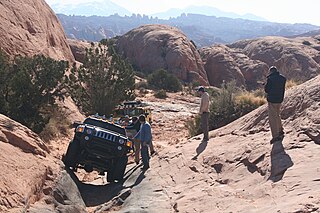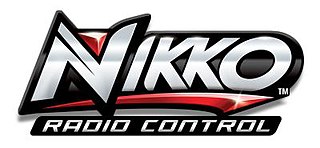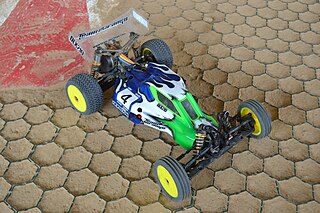
ZipZaps are miniature radio-controlled cars that were sold by RadioShack, later marketed under the brand name XMODS Micro RC. They were commonly compared to Tomy's Bit Char-G (sold in the U.S. as MicroSizers) and Takara's Digi-Q micro R/C lines. [1]

ZipZaps are miniature radio-controlled cars that were sold by RadioShack, later marketed under the brand name XMODS Micro RC. They were commonly compared to Tomy's Bit Char-G (sold in the U.S. as MicroSizers) and Takara's Digi-Q micro R/C lines. [1]
First introduced in September 2002, ZipZaps were an instant success and one of the most popular gifts of the holiday season in North America, [2] [3] with RadioShack stores often selling out of the starter kits. [4] They were referred to as "micro R/C" due to their diminutive size. At around 1:64 scale, ZipZaps were only slightly larger than popular die-cast toy cars such as Hot Wheels and Matchbox. [5]

ZipZaps were unique among toy-style micro R/C vehicles in that they could be customized much like large R/C models. Each partially assembled ZipZaps kit included a pre-assembled chassis with built-in nickel metal hydride rechargeable batteries on which the gears, tires and hubcaps could be changed for better appearance and performance. [6] [7]

Six motors and three gear ratios were offered, ranging from the 10,000 rpm "precision control motor" to the high-speed 34,000 rpm "NX" (named after a popular brand of nitrous oxide). Gear ratios were 12:1 "stock", 9.86:1 "performance" and 8.25:1 "turbo". Tracking was adjusted via a wheel alignment lever underneath the vehicles themselves. The vehicle's on-board battery was charged by snapping the entire car onto the top of the transmitter. Full charge was accomplished in about 40 to 60 seconds with run times averaging five minutes. Neither steering nor throttle was proportional, with both functions either full on or full off. The SE series added semi-proportional, two-speed throttle and fully proportional rack-and-pinion steering with steering trim adjustable at the transmitter, as with a full-sized R/C.
Further customizing options came from the variety of body shells which snapped on over the top of the chassis, allowing the car to take on the appearance of any number of popular cars including the Chevrolet Corvette, Toyota AE86, Audi TT, Ford GT, Ford Mustang, Hummer H1 and Mercedes-Benz SL. "Past and present" two-packs of body shells were sold as well, depicting early and late versions of sports cars and muscle cars. In addition to selling the Initial D manga, RadioShack also sold bodies for the SE chassis of the AE86 Trueno and the AE85 Levin from the series in a two-pack (which also included a few performance gears and motors) for the holiday season in 2002. Motion picture vehicles were represented by the Ford Gran Torino from Starsky & Hutch and the tuned imports from 2 Fast 2 Furious . RadioShack marketed a replica of Herbie that tied in with the Walt Disney Studios 2005 release of Herbie: Fully Loaded . In 2007, Radioshack released a set of ZipZaps for the live-action Transformers film, featuring Optimus Prime (the only model to feature a six-wheel chassis), Barricade, and Bumblebee. A series of monster trucks based on a larger chassis and with larger tires and motors and four wheel drive were available as well.
The original ZipZaps operated on one of two frequencies: namely 27 MHz and 49 MHz, so no more than two people can reliably race simultaneously. The SE series and monster trucks featured selectable frequencies within the 27 MHz band for up to six racers along with working headlights and taillights. The SE series had proportional control and used a pistol grip style remote control. Motors, tires and wheel covers (called "hubs") were interchangeable between regular ZipZaps and the SE series. The bodies were also interchangeable, but the lights on SE bodies obviously did not work on the regular chassis. Accessories such as lap counters, autocross pylons and carrying cases were available as well.
The popularity of ZipZaps waned somewhat in 2004 with RadioShack's introduction of XMODS. Like ZipZaps, XMODS offered customization options in both appearance and performance potential, but were considerably larger at 1:28 scale. [8]
In October 2008, RadioShack relaunched the ZipZaps line – this time, as XMODS Micro RC. Only the name was changed; all parts were backwards and forwards-compatible between ZipZaps (except the light features of the SE line) and XMODS Micro RC lines, and used the same chassis and controller of the regular ZipZaps line (as opposed to the more advanced features of the SE line).
Radio-controlled cars are miniature model cars, vans, buses, trucks or buggies that can be controlled from a distance using a specialized transmitter or remote. The term "RC" has been used to mean both "remote controlled" and "radio controlled"."remote controlled" includes vehicles that are controlled by radio waves, infrared waves or a physical wire connection, but the latter term is now obsolete. Common use of "RC" today usually refers only to vehicles controlled by radio, and this article focuses on radio-controlled vehicles only.

A radio-controlled model is a model that is steerable with the use of radio control. All types of model vehicles have had RC systems installed in them, including ground vehicles, boats, planes, helicopters and even submarines and scale railway locomotives.

Steering is a system of components, linkages, and other parts that allows a driver to control the direction of the vehicle.
HPI Savage is a line of radio-controlled monster trucks manufactured in Japan by Hobby Products International of Foothill Ranch, California, US.

Mini 4WD is a powered toy car generally 1:32 in scale equipped with 4WD. The cars can be used for miniature auto racing, being built to race around a U-shaped track.

XMODS were 1:28 scale electric radio-controlled cars. Originally invented by Nobuaki Ogihara in Japan, XMODS were released with several body styles over multiple generations. Due to the popularity of tuner culture in the early to mid 2000's, the cars' primary marketing focus was on customization. This was reflected by the various first party body kits and upgrades released with XMODS. The cars were distributed by RadioShack in the United States, by Hobby Products International in Japan, Mirage RC in the U.K., and by Carson Modellsport in Europe.
A power steering is a mechanical device equipped on a motor vehicle that helps drivers steer the vehicle by reducing steering effort needed to turn the steering wheel, making it easier for the vehicle to turn or maneuver at lower speeds.

Schuco is a German manufacturing company founded in 1912 by Heinrich Müller and the businessman Heinrich Schreyer in Nuremberg Germany's toy capital since early days. The company's specialty was making toy reproductions of cars and trucks in tin, plastic and die-cast. The company went bankrupt in 1976 but was reorganized in 1993 and then totally independent again by 1996.

Rock crawling is an extreme form of off-road driving using specialized vehicles ranging from stock to highly modified to overcome obstacles. In rock crawling, drivers typically drive highly modified four-wheel-drive vehicles such as trucks, Jeeps, and "buggies" over very harsh terrain. Driving locations include boulders, mountain foothills, rock piles, mountain trails, etc.
The Associated RC18T is a 1:18 scale, ready-to-run electric stadium truck made by Associated Electrics of Lake Forest, California. A mechanically similar monster truck version with slightly different bodywork similar to the 1:8 scale, nitromethane-powered Associated "Monster GT" and all-terrain tires with unique "AE" tread pattern is sold as the RC18MT.
Kyosho Corporation is a Japanese company based in Tokyo, which operates internationally under the name KYOSHO. The company's main office is located in Chiyoda, and the production headquarters are located in Atsugi, Kanagawa.

Johnny Lightning is a brand of diecast model cars launched in 1969 by Topper Corporation, similar to the hugely successful Mattel's Hot Wheels cars. Their claim to fame at that time was that they were extremely fast compared to other brands of die-cast cars. Their most important technology was to mold in a small hook under the front axle so that they could be propelled by a lever-driven catapult, far faster than could be obtained by either gravity, or battery powered "supercharger" devices.

Nikko R/C is the largest toy-grade radio control manufacturer in the world. The company's licenses include those from Dodge, Ford, Volkswagen, Chevrolet, Porsche, as well as proprietary designs. In 2014, Nikko was acquired by global toy company, Toy State. In 2017, Toy State created a new arm of the Nikko brand, Nikko Air. In 2019 Nikko Toys Ltd. became the new home of the Nikko RC brand.

Mini-Z is a brand name for a popular line of 1:28-scale electric radio-controlled cars manufactured by Kyosho Corporation, a Japanese manufacturer of various radio-controlled devices. Kyosho makes a huge number of bodies for the Mini-Z. The wheelbase can range from 86mm to 106mm. The bodies are all highly detailed, realistic looking, and fully painted with a high gloss paint. The bodies are so realistic that many are collected as display models and the bodies come with a dummy chassis and wheels for display purposes.

Horizon Hobby, LLC. is an American international hobby product distributor, headquartered in Champaign, Illinois, United States. It currently manufactures various hobby-grade radio-controlled (RC) models, as well as Athearn model trains and die-cast models, which it sells direct to consumers as well as to hobby retailers.
The Tamiya TXT-1, which stands for Tamiya eXtreme Truck, was one of Tamiya's 1/10 scale radio controlled (RC) Monster Trucks.
The Tamiya Radio Controlled Nitro Off-road Vehicles entered the radio controlled (RC) nitro engine powered 1/8 scale truck market in July 2002. Produced by the Tamiya Corporation of Japan, these 1/8 scale trucks are designed for stadium competition. Tamiya's first nitro truck, TR-15t, was introduced in 1994. Second truck was the TGM-01 Mad Bison, released in 2000. Third attempt, Terra Crusher, departed greatly from the previous two. Terra Crusher (TGM-02), released in July 2002, capitalized on the off-road monster RC boom of the time; subsequent trucks include the Wild Commando, TNX (TGM-03), TNX 5.2R, and TRG-01 Nitrage. The trucks perform in competitions for Remotely Operated Auto Racers (ROAR) abbreviated as ROAR. ROAR is the sanctioning body of competitive radio-controlled car racing in the United States and Canada, overseen by IFMAR.
Motorific is the brand name of a line of battery-operated slot car toys and related accessories marketed by the Ideal Toy Company from 1964 to the early 1970s. It differed from traditional slot car sets in that the cars were powered independently by a pair of AA batteries, rather than by an electrical connection to the track.

A 1:10 radio-controlled off-road buggy is a 1:10 scale radio-controlled dune buggy designed for off-road racing. These cars are based on their full-scale equivalents that are commonly found in desert racing. The buggies are split into two race categories, two (2WD) and four-wheel drive (4WD). These can easily be distinguished visually by their wheel size at the front. Cars are typically electric powered, but nitro versions do exist but are less common because racing classes exist for electric cars. The class is inexpensive and similar to a number of other classes, and this makes them popular with newcomers. The cars are also known as 1/10 off-road.